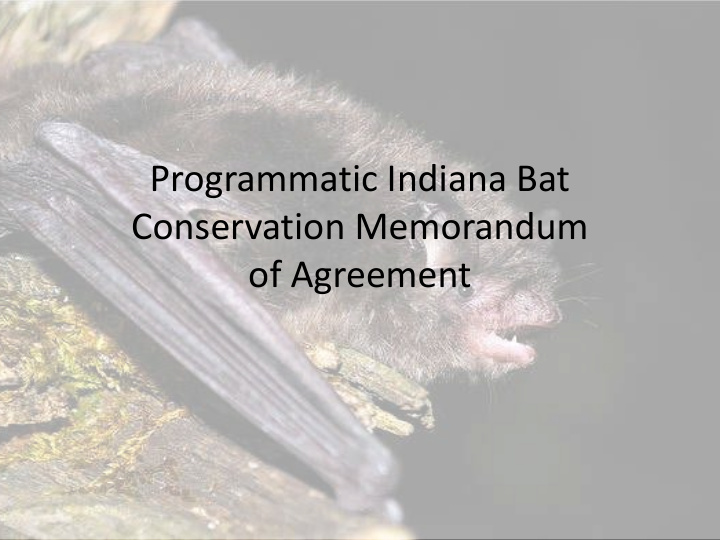



Programmatic Indiana Bat Conservation Memorandum of Agreement
Purpose of the Agreement • Streamline or eliminate project specific consultation process • Reduce costs • Promote the survival, conservation, and recovery of the Indiana bat by providing tangible benefits to the species • May replace but does not prohibit use of presence/absence surveys
Purpose of the Agreement “…this MOA provides recovery based conservation benefits for the Indiana bat in the form of habitat protection and/or voluntary contributions to the IBCF which in turn will fund habitat protection, conservation, restoration and/or priority monitoring and research projects for the Indiana bat.”
Framework for the Consultation • USFWS intra-service Biological Opinion for loss of summer roosting habitat statewide – Authorized up to 2,500 acres/12,500 acres of take per year/5 year – Framework for Conservation MOAs – Method for calculating minimization contribution to IB Conservation Fund – Available for anyone seeking ESA coverage – Monies used for tangible benefits to IB
Known Occurrences
Cost Calculation Table 1. MITIGATION MULTIPLIER BY HABITAT TYPE AND SEASON August 16- October 15- April 1-August 15 October 14 November 14 Determine habitat type (swarming (swarming and (swarming unoccupied*; potential occupied; affected Determine seasonal November potential, occupied; potential, 15-March 31 maternity** and maternity and maternity and sensitivity (all habitats non-maternity non-maternity non-maternity unoccupied) occupied unoccupied unoccupied Known Maternity +P1&2 swarming 2.5 3.0 (4.0) 3.5 3.5 Known Maternity +P3&4 swarming 2.0 2.5 (3.5) 3.0 3.0 Known non-maternity +P1&2 swarming 2.0 2.5 (3.5) 3.0 3.0 Known non-maternity +P3&4 swarming 1.5 2.0 (3.0) 2.5 2.5 Select the Swarming P1&2 1.5 2.0 (3.0) 2.5 2.5 appropriate multiplier Swarming P3&4 1.0 1.5 (2.5) 2.0 2.0 Known maternity 1.5 2.0 1.5 1.5 Known non-maternity 1.0 1.5 1.0 1.0 Potential 0.5(0.0) 1.0 (0.5) 1.0(0.5) 0.5(0.0)
Indiana Bat Mitigation Guidance • Guidance document that details the applicability and use of the IB Conservation Fund including: – explanation of terms – identification of certain priority habitats – determination of the standard tree canopy size for the single tree method – determination of situations which require direct consultation with the Service – acceptability of mitigation measures – calculation of impacts and mitigation measures
Programmatic Consultation • KYTC Programmatic BA • Tier 1: – Screens project types and identifies those defined as No Effect – Assesses and screens No Habitat/No Effects – Identifies impacts with special conditions • Tier 2: Address impacts through BA or mitigation via IBCF
What’s covered? • Available for all KYTC project types • Project consultation not required for: – Removal in “potential” area w/seasonal tree cutting (October 15-March 31) – Tree trimming within 100 feet of pavement – Removal of up to two acres of roadside habitat for maintenance w/i 500 feet)
Limitations Projects that are not automatically covered • Loss of more than 250 acres of habitat/project • >300 ac/year and >1200 ac through Jan. 2016 • Within 1 mile of priority 1 or 2 hibernacula • Within ½ mile of priority 3 or 4 hibernacula • Projects resulting in impacts to known maternity habitat between June 1 and July 31. • Projects impacting caves, portals, or mine adits suitable for use by Indiana bats MAY NOT use the PCMOA.
Features • Mitigation due prior to impacts • Acreage calculated through GIS and/or tree counting • “Potential” area considerations – New alignment vs. existing alignment – 50 percent of the total disturbance area associated with the project is within 500 feet of the edge of pavement • Can propose other property acquisition in lieu of payment to IBCF
New or Existing Alignment?
Mechanics • Ledger of projects within seven days of monthly letting • Identifies: – Habitat type – Acreage of impact – Appropriate multiplier given timing – Cost of IBCF Contribution • USFWS through KNLT issues invoice with payment due within 30 days
Check and Balance • USFWS may request to audit project records • KYTC must reevaluate prior to letting to determine if determination consistent with current mapping • If habitat designation has changed, must consult and adjust
Bridge Habitat • Unless bridge is unsuitable as habitat KYTC shall: – Prior to construction/demolition, conduct inspection of the underside of the bridge for use or signs of use by bats – If present, coordinate with Service regarding minimization measures
Benefits • A 50% reduction in costs for impacts along existing highways • Allows for limited trimming and removal of trees along existing corridors for maintenance and other activities • Provides a more cost effective option to conducting time consuming and expensive biological surveys • Allows seasonal tree removal in areas where Indiana bats may “potentially” roost • Eliminates project specific Conservation MOAs for loss of Indiana bat summer roosting habitat
More Benefits • Eliminates the need for project specific consultation for many projects • Provides flexibility in timing of payments that is favorable to the KYTC • Uses credit of KYTC site preservation occurring through the stream and wetland mitigation program • Addresses Section 7 consultation issues with the US Army Corps that will streamline that process
Questions
Recommend
More recommend